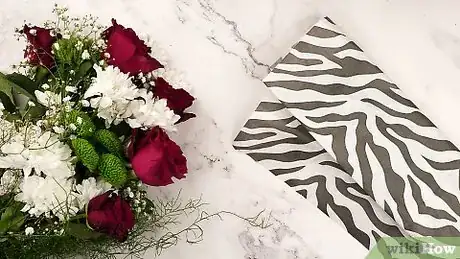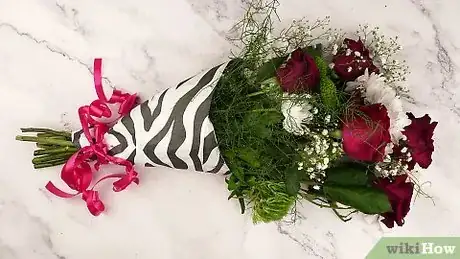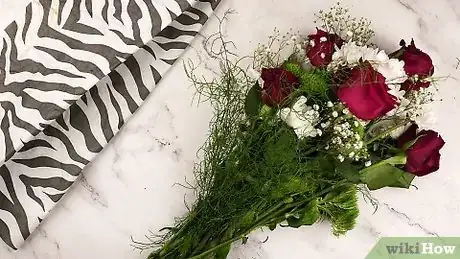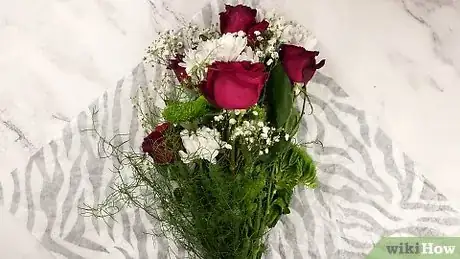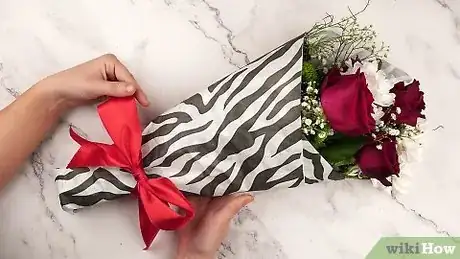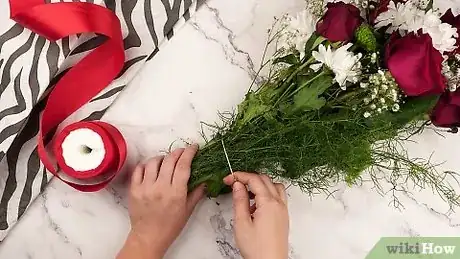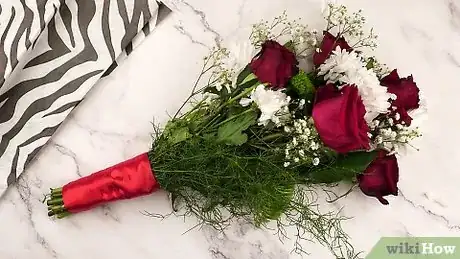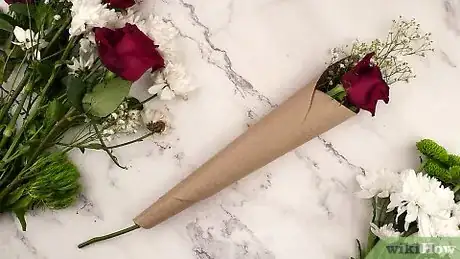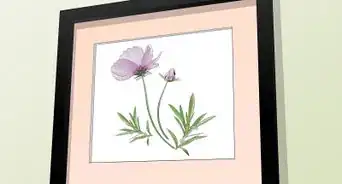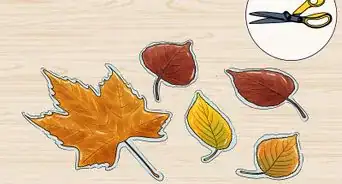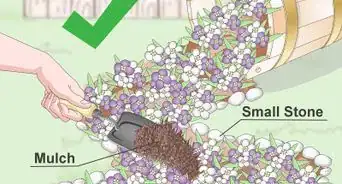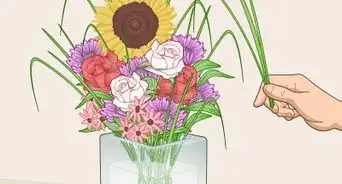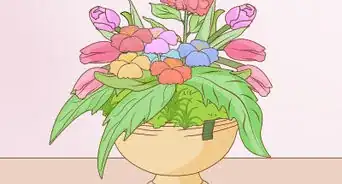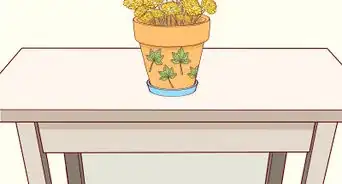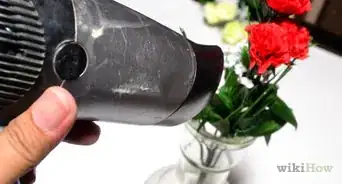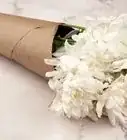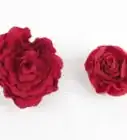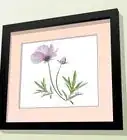This article was co-authored by Pilar Zuniga and by wikiHow staff writer, Jessica Gibson. Pilar Zuniga is a Floral Designer and the Owner of Gorgeous and Green, a floral design studio and Certified Green Business based in Oakland, California. Pilar has over ten years of experience in floral design. With a focus on being earth-friendly and supporting local growers, Gorgeous and Green has been featured in Energy Upgrade California, Molly My, Apartment Therapy, 100 Layer Cake, Design Sponge, and Trendy Bride. Her studio provides floral arrangements and gift basket, event and wedding design, and she teaches workshops on flower design and sustainability in her industry. Pilar received a BA in Anthropology from the University of California, Berkeley in 2001.
This article has been viewed 416,546 times.
Flowers are a great way to cheer someone up. If you'd really like to make your flower bouquet appear more polished, wrap the flowers before presenting them. When it comes to wrapping your flowers, consider the wrapping as another element of the bouquet.[1] For a dramatic look, consider leaving the stems exposed. Or for a rustic appearance, completely wrap the stems so that only the flowers are exposed. You can also give the simple gift of a single wrapped flower. Dressing it up with a ribbon or string can really make it stand out.
Steps
Wrapping Flowers With Exposed Stems in Paper
-
1Choose paper. You can use almost any type of paper to wrap flowers. If you want a simple classic look, choose plain brown craft paper. For a dressier look, choose wrapping paper or decorated wrapping sheets. For a unique look, think about using:[2]
- Newspaper
- Pages from old books (if you're wrapping small flowers)
- Sheets of music
- Colored tissue paper that coordinates with the colors in the bouquet or contrasts with the flowers to make them pop.[3]
-
2Place the flowers on the paper. Secure the middle of your flower stems with a rubber band. This will make them easier to wrap and keep them from coming loose in your paper. Set the flowers on your paper so that the rubber band lines up with the folded edge of the paper.[4]
- A small portion of the stems will be wrapped. However, the flowers should cover a lot of the paper while plenty of stems are exposed.
Advertisement -
3Fold the paper in half. Lay your paper on a table so the printed or colored side is face down. Bring the side closest to you up and over so you can fold it about halfway. Fold the paper at an angle so some of the plain side is exposed.[5]
- If you're not using colored paper, you should still fold the paper over at an angle. This will create decorative folds in the wrapped bouquet.
-
4Wrap the paper around the flowers. Fold one side of the paper up and over the flowers so that it reaches the other side. You can then roll the bouquet so that all the paper is wrapped up, or you can fold the other side across the flowers.[6]
- This method will make a bit of a cone-shape and can be good for wrapping a bouquet with varying sizes of flowers.
-
5Secure the paper. Take a few pieces of clear double-sided tape and place them on the folds of paper that overlap. Press the taped pieces together so that the wrapped bouquet doesn't come apart when you move your hands away. If you don't have tape, you could use twine or string. You'll just need to wrap the string or twine tightly so the paper doesn't unwrap.[7]
- You can finish your bouquet by wrapping a bow at the base of the paper, where it meets the stems.
Wrapping the Flowers and Enclosing the Stems in Paper
-
1Select your paper. To support a delicate bouquet, you may want to use brown craft paper or a thick wrapping paper. If your flowers have strong stems and blooms, you can use a more delicate paper, like tissue paper or newsprint.
- Choose a color that will look good with your flowers, not compete with it. For example, if you have an orange flower, think about using red and yellow tissue paper which will bring out the orange color.
-
2Wrap the stems of the flowers together. Trim the stems of your bouquet so they're the same length. Tie a rubber band around the stems so the stems don't come loose. The rubber band will be hidden when you wrap the flowers in paper. Wrap a paper towel around the end of the stems to prevent water from leaking out of the flowers and onto the paper.
- To keep your flowers fresh for longer, consider soaking the paper towel in water. Then wrap the wet paper towel around the stems. Cover the wet paper towel with plastic wrap to prevent the water from soaking into the paper.
-
3Place the flowers on the paper. Lay a square of your paper at a diagonal (so it looks like a diamond) in front of you. If you want the colorful part of the paper on the outside, lay the paper so the plain side is facing you. If you want just a little color to show, place the plain side down so the color faces you. Lay the flowers on the paper so the blooms are above the top square of the paper. Most of the stems should be going straight down the middle of the paper.
- For an average bouquet, you'll probably want a square of paper that measures 2-feet by 2-feet.
-
4Fold one side of the paper. Hold the right corner that's closest to you and the bottom corner that's nearest to you. Fold this side over toward the flowers. The fold should be an inch or two thick. If your bouquet is small, you may want to do another fold or two so the fold ends up close to the stems of your bouquet.
- A large bouquet with long stems might only need one fold.
-
5Fold the left side of paper over the flowers. Take the left corner of the paper and fold it up and over the flowers. The paper should almost reach the side of the paper that you just folded.
- If you want to really secure the wrapped flowers, you can use clear-sided tape to tape these folds.
-
6Fold the bottom of the paper up. Carefully hold your fold in place over the flowers and take the long thick fold near the bottom with your other hand. Continue folding or rolling this side up towards the middle of the flowers.[8]
- It's important to fold the corners in this order so the bottom fold makes a kind of base or bottom for your flower stems.
-
7Fold or roll the right side of paper. Once the left and bottom sides of the paper are covering the flowers and stems, finish rolling or folding the paper on the right side. You should now be able to hold the flowers in wrapped paper.
- If you want a tightly wrapped bouquet, finish rolling the paper tightly so you create a lot of tension. For a looser bouquet, just gently fold the remaining paper over.
-
8Secure the bouquet. Use ribbon, twine, or string to wrap around the paper. Wrap around the paper several times so that the paper doesn't come undone. If your paper is very thick, you may want to use clear double-sided tape to tape the folds together.
- You may want to place a large decorative ribbon on the outside of your wrapped flowers. This can give the bouquet a professional look.
Wrapping Flowers in String or Ribbon
-
1Gather the flowers together. Hold all of the flowers with one hand so your palm is enclosing the stems. Take a rubber band and wrap it around the stems at the point where you're holding them.[9]
- The rubber band will be covered up. It will ensure that individual flowers don't fall out of the bouquet.
-
2Attach a looped string to a stem. Take your string or ribbon and make a loop on one end. Slip the loop onto just one flower stem and slide the loop up so that it's near the rubber band.[10]
- The looped stem gives your string or ribbon a starting point for wrapping the bouquet. This will also make sure that the string or ribbon doesn't unravel from the bouquet.
-
3Wrap the string or ribbon around the stems. Evenly wrap the string or ribbon around your grouped stems. Keep wrapping until you've covered as much of the stems as you want.[11]
- If you have wide ribbon, you probably won't need to wrap around the stems very many times. Keep in mind that wrapping several layers of string or ribbon will strengthen and support the bouquet.
-
4Finish off the string or ribbon. Once the flowers are secure and wrapped as much as you like, bring the string or ribbon back to the front of the bouquet. Cut the string or ribbon and weave it into the wrapped stems.
- You can also tie a ribbon or string bow to the front of the wrapped stems to hide the end of the wrapping.
-
5Try wrapping individual flowers. If you want to give a single bloom, make it really stand out by wrapping it. Roll the stem in a small piece of brown craft paper and roll twine around it to tighten and secure it. You could also use a small cloth square to wrap around the stem. Wrap ribbon around it to secure it.[12]
- If the flower is very small, you could twist one end of the paper into a cone. Place the small flower into the cone so it sits in the narrow end of the cone.
Things You'll Need
- Flowers
- Wrapping or tissue paper
- Clear tape
- Ribbon
References
- ↑ Pilar Zuniga. Florist. Expert Interview. 12 March 2020.
- ↑ http://www.brit.co/floral-wrap-diys/
- ↑ Pilar Zuniga. Florist. Expert Interview. 12 March 2020.
- ↑ http://www.hgtv.com/design/decorating/design-101/how-to-wrap-a-bouquet-of-flowers
- ↑ Pilar Zuniga. Florist. Expert Interview. 12 March 2020.
- ↑ http://www.hgtv.com/design/decorating/design-101/how-to-wrap-a-bouquet-of-flowers
- ↑ http://www.hgtv.com/design/decorating/design-101/how-to-wrap-a-bouquet-of-flowers
- ↑ Pilar Zuniga. Florist. Expert Interview. 12 March 2020.
- ↑ http://www.homeyohmy.com/3-easy-ways-to-wrap-flowers/
About This Article
If you want to wrap flowers in paper while leaving the stems exposed, put an elastic band around the stems to hold the flowers together before placing them on your paper. Fold the side of the paper nearest to you about halfway up, then fold one side of the paper over the flowers so it reaches the other side. To finish, roll the bouquet until all of the paper is wrapped. For tips on how to wrap flowers with a ribbon and how to cover the stems, read on!

